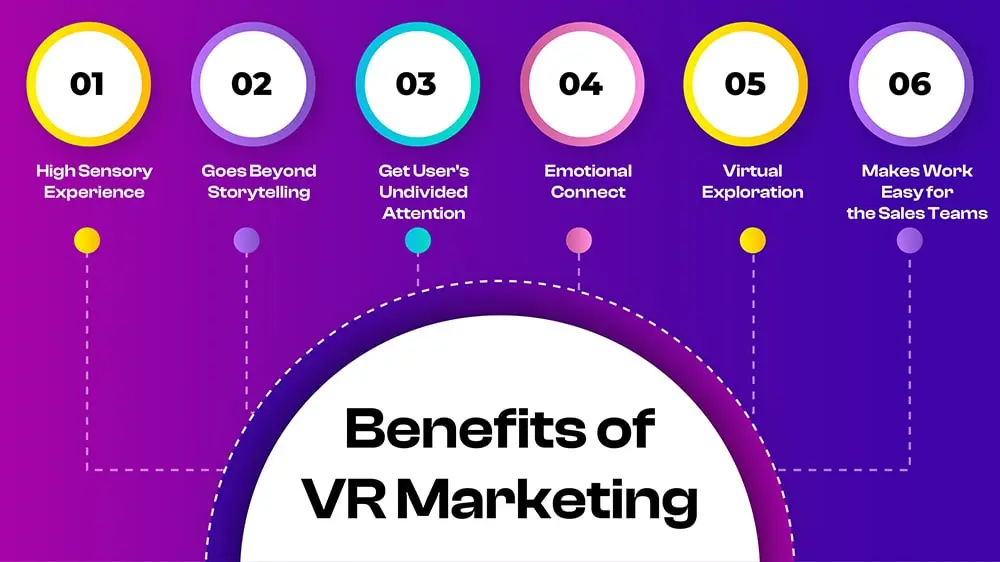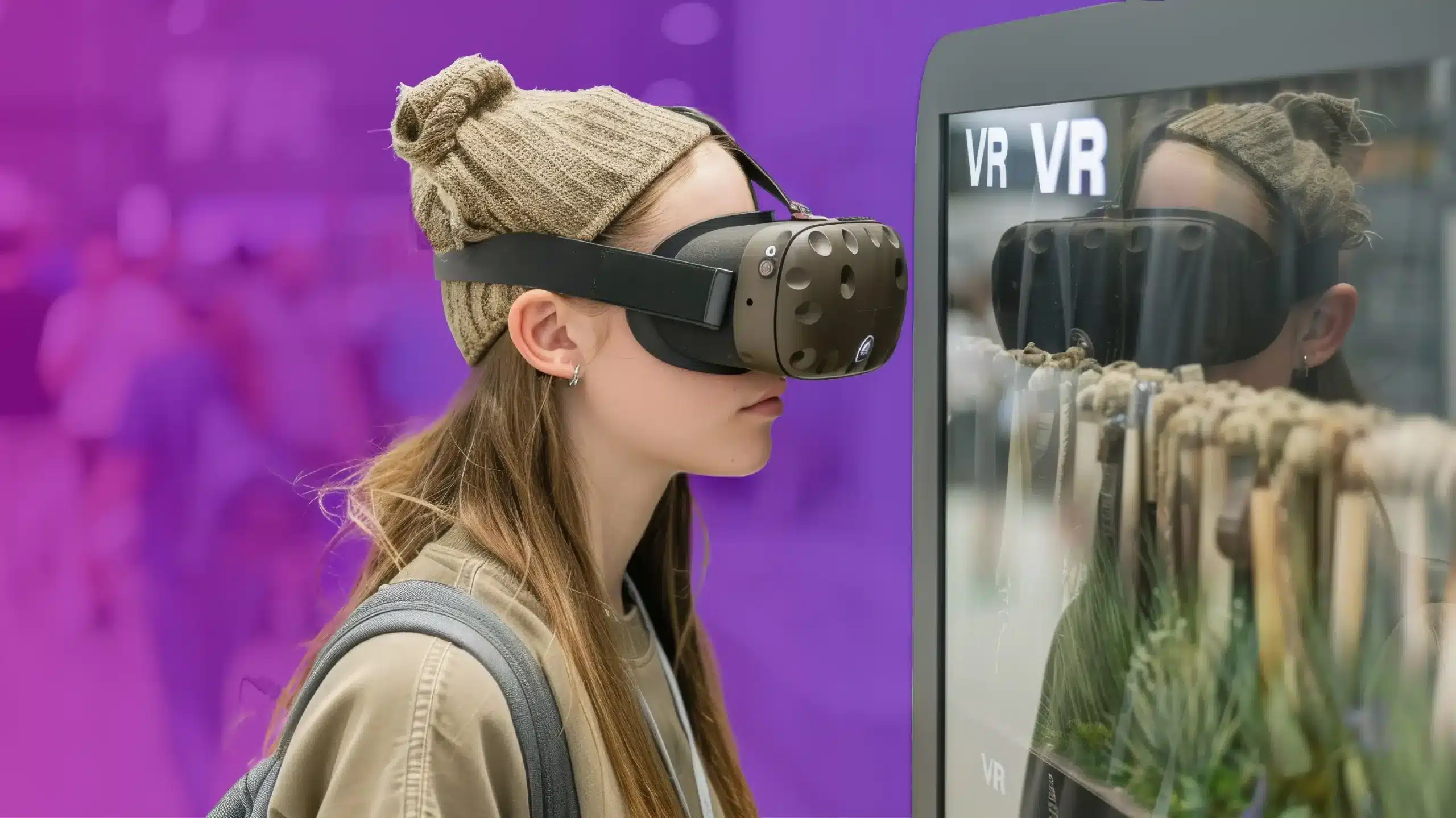VR Marketing: Definition, Benefits, Examples
- wtsverse
- September 13, 2024
VR is fascinating in itself, and VR marketing is bringing in a revolution for big brands. Many businesses from different industries are using VR for innovation and sales growth.
Global virtual reality marketing revenue may grow to $174 million in 2024, according to Statista. Further, it shows an estimated CAGR of 1.35%, which will take the revenue to $186.1 million by 2029. Hence, those using this technology will enjoy the advantages over those who don’t.
Here, we’ll discuss marketing with VR and its benefits. There are also some real-life virtual marketing examples. So, you can see how businesses harness VR’s power in marketing.
What is VR Marketing?
VR marketing utilizes VR content to promote their brands and products. There are endless possibilities, such as virtual tours using 3D models. All are accessible when you wear a VR headset.
With VR, users feel like a part of the world your brand has created. Also, you can showcase products in the most immersive way. It makes a more lasting impression on their minds than a spot in glossy magazines.
Benefits of VR Marketing:

High Sensory Experience
Immersive virtual reality feels as if your body is in the virtual world. It stimulates our senses of hearing and sight. Also, motion and balance and our awareness of our bodies are affected. Sensory clues increase the emotional connection with the experience. Thus, it increases our memories of the experience.
Goes Beyond Storytelling
Your presence in the virtual world allows you to live the story rather than being an observer. When you let the viewers experience what’s happening, it results in more involvement.
Get User's Undivided Attention
The VR headset is a complete commitment to the immersive experience for the user. There’s no room left for distraction.
Emotional Connect
The virtual world is so powerful that it can change how people think, feel, or behave. It can help you emotionally connect your users to social causes.
Virtual Exploration
With VR, one can explore far-flung locations or travel back to the past or future. Thus, you can allow testing for products that have not yet been released.
Makes Work Easy for the Sales Teams
Apart from showcasing products, one could use virtual reality to sell products. VR allows customers to go from looking at and learning about a product swiftly. It significantly cuts down on the number of questions that sales representatives receive.
How to use VR in Marketing:
Virtual Demos
You can provide an immersive and enjoyable experience to showcase your products. Virtual demonstrations are a unique method to attract attention and boost sales.
Virtual Events and Conferences
Organize virtual gatherings that provide similar levels of interaction as live gatherings. Participants can explore virtual conference rooms and interact with exhibitors. They can even attend keynote sessions from their homes.
Virtual Store Experiences
One can browse through shelves or try out virtual clothes. Shoppers can have an immersive shopping experience from anywhere. This kind of VR experience leaves a lasting impression.
Market Research
Gathering data isn’t the primary goal of many VR applications. Still, you can easily track users’ actions and decisions in these apps. They can offer valuable insight and unsaid feedback.
Branded Games
VR games raise the brand’s visibility and introduce them to your products in an enjoyable way.
Some Fascinating Virtual Marketing Examples:
Many big brands have started using VR to engage customers in intriguing ways. Here are some of the fascinating VR examples:
McDonald's: Happy Goggles
McDonald’s turned its Happy Meal box into a VR device, like Google’s Cardboard. These happy goggles allowed kids to play a fun and educational VR game like Slope Stars. McDonald’s made virtual reality accessible through their limited-edition Happy Meal boxes.
GSK's Real Migraine Experience
Most people think that migraines are similar to headaches. They’re not. GSK demonstrated this through the VR Excedrin Migraine Experience.
Here, they recreate what it’s like to suffer from migraine. The simulator gives its users a taste of the lives of those suffering from migraines. It simulates vision symptoms, including auras, light sensitivity, and other struggles.
GSK educated users about migraine and created feelings of empathy for this condition.
Volvo Reality Test Drive
Volvo developed a VR adventure that takes its customers for a drive on their XC90.
The trip featured stunning mountains and an inside view of the interior. The “Volvo Reality” application reached over 20,000 users. Through this campaign, many came seeking more information about the car.
L'Oreal Paris: Makeup Genius App
L’Oreal’s Makeup Genius app allows customers to play with different makeup looks. It lets users simulate trying on makeup and experiment with curated looks.
It also gave users personalized advice and notifications about the latest L’Oreal products.
Merrell: Trailscape
Merrell’s Trailscape has virtually transported users on a mountain trek. It uses motion capture technology to give users an immersive experience in 4D.
Users explored the rope walkways and faced mini-crises such as landslides. With Trailscape, Merrell promoted their new Capra hiking boots.
IKEA: IKEA Place
IKEA Place is a VR-based application. It lets customers virtually place 3D models of IKEA’s furniture within their homes. Customers could see how a particular piece of furniture looked in their home.
Samsung 837X
Samsung launched its immersive virtual world called 837X in 2022. It modeled Samsung’s flagship store in New York City.
They further evolved this virtual world into a gamified experience. It has detailed landscapes and magical characters to join the user on an adventure.
Also, users can complete challenges and earn rewards, such as NFTs (non-fungible tokens).
Nikeland
Nikeland is a virtual environment modeled after the Nike headquarters in Beaverton, Oregon. It has Nike structures, fields, and areas where players can play various minigames.
Users can buy Nike’s latest digital merchandise as avatars in the virtual world.
Etsy Virtual House
Etsy introduced its “virtual home” in 2021. It allows buyers to “walk through” a virtual home filled with Etsy products. They customized the home with photorealistic, accurate-to-scale renderings, seamlessly flowing navigation, and 360-degree views.
Every item in that home is available to buy. All the users need to do is hover over an item, and a pop-up will show more information and an option to buy.
London Natural History Virtual Museum
The London Natural History Museum (NHM) uses VR to develop immersive educational materials. So, even if the museum is closed or you are not present there, with 3D technology, you can virtually explore Earth Hall, Hintze Hall, and Darwin Centre. This virtual tour also lets you see the galleries and listen to audio guides.
How to Launch Your Own VR Marketing Campaign:
Understand Your Audience
Know about your audience’s demographics and understand their preferences and habits. These data will help you ensure your users’ engaging and mesmerizing experience.
Create Compelling VR Content
Create an engaging, straightforward narrative that uses VR’s capabilities. Hire well-trained 3D artists and virtual engineers. So they can ensure high-quality content, user engagement, and enjoyment.
Right Choice in Technology
Select headsets and accessories that are affordable and suitable to your audience. The VR software must also be compatible with the campaign’s graphic requirements.
Promotion
Use social media and other marketing channels to draw attention to your VR campaign. Collaborate with influencers as they can help expand your reach and establish credibility.
Inauguration of the VR campaign
Start with a beta version to collect feedback and make necessary adjustments.
After that, you can go through with the full launch. Ensure the technical aspects are flawless and the interface is easy for users.
After-launch Analysis
Analysis and feedback will help you understand how people interact through the experience. It will help you make improvements for future campaigns.
KPIs to Consider
Pay attention to these Key Performance Indicators (KPIs) to check your VR campaign.
- User Engagement
- Time Spent in the VR World
- Conversion Rates
Conclusion:
Although VR marketing is expensive, it’s becoming popular. Virtual reality marketing is revolutionizing our way of looking at and viewing brands.
Different industries, like tourism, healthcare, and real estate, use VR’s. So they can design memorable and mesmerizing marketing campaigns.
Virtual reality has endless possibilities. It can take us to far-off places and let us experience the world from someone else’s point of view. We can only wonder how far it can go and what new, thrilling experiences it will bring us.
FAQs:
How is VR different from AR?
VR (Virtual Reality) immerses you entirely in a virtual world, while AR (Augmented Reality) only shows digital elements into your real world.
Is it expensive to launch VR marketing campaigns?
Yes, virtual reality marketing campaigns are indeed expensive. You need specialized hardware, software, and a team of experts.
What are some challenges in virtual reality marketing?
VR headsets have limited resolution, comfort, and battery life. Also, only some people have access to these accessories.
Some users also face discomfort or nausea when using VR headsets.
Which industries are using VR the most?
Retail, real estate, automotive, healthcare, and tourism are making the best use of VR.
How can brands measure the success of their campaigns?
Brands use some KPIs to measure their campaign success. Some KPIs are user engagement, time spent, and conversion rates. They also consider feedback and post-launch analysis.
How can small businesses start with VR marketing?
Small businesses can start with affordable VR solutions. You can use 360-degree videos and Google Cardboard.

